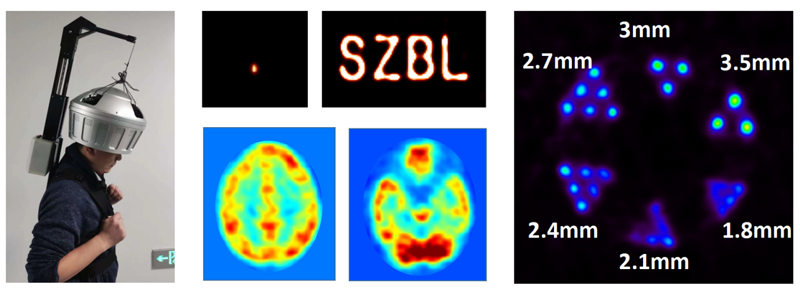
Bring Science Solutions to the World.
Peng, Qiyu
彭旗宇
Institute of Biomedical Engineering
IBE Vice Director ,Senior Principal Investigator
pengqy@szbl.ac.cn
Home page of research group:http://pengqy-lab.szbl.ac.cn/
Timeline
-
2022 - Present
SZBL-Sun Yat-sen University Seventh Affiliated Hospital Molecular Imaging Center Founder and Head
-
2021 - Present
Shenzhen Bay Laboratory Senior Principal Investigator, Vice Director of IBE
-
2015 - 2021
Lawrence Berkeley National Laboratory, USA Career Scientist
-
2009 - 2014
Lawrence Berkeley National Laboratory, USA Research Scientist (Career Track)
-
2007 - 2010
University of California, Berkeley Lecturer
-
2005 - 2006
Stanford University Post-doctoral Researcher
-
2003 - 2005
Northwestern University Post-doctoral Researcher
-
2000 - 2003
Tsinghua University PhD student
Peng Lab (AMIL-SZBL): http://pengqy-lab.szbl.ac.cn/
Research Areas
(1) Research and development in key Positron Emission Tomography (PET) technologies. This includes gamma detectors with high spatial and time resolutions, advanced nuclear electronics, and image reconstruction and processing based on deep learning techniques. For instance, our current research on PET detectors with an ultra-high time resolution of 100ps and super-high resolution below 250μm is expected to drive the evolution of PET molecular imaging towards microscopic imaging.
(2) Development of the next-generation high-performance PET, PET/CT and PET/MRI systems, and radiotherapy systems under PET guidance, to meet scientific and clinical needs. For instance, an ongoing project is the development of a wearable, mobile brain TOF-PET system. This innovation aims to revolutionize traditional stationary imaging by facilitating dynamic brain functional imaging of animals and humans in alert, active, task-specific, and more natural settings. This offers new tools for neuroscience research and clinical treatments of major brain disorders, such as Alzheimer's Disease (AD) and Parkinson's Disease (PD).
(3) Dissemination and translations of the high-performance PET molecular imaging technologies, devices, and methods in the mechanism research and clinical diagnosis and treatment of cancers, brain diseases, and cardiovascular diseases. For example, a cardiac-specific TOF-PET system is under development, promising a cost-effective diagnostic tool for major cardiovascular diseases like ischemic heart disease, heart failure, cardiac inflammation, and valve disorders.
Highlights
Prior to my affiliation with ShenZhen Bay Laboratory (SZBL), I worked as a career scientist for 16 years at the Lawrence Berkeley National Laboratory (LBNL) - the birthplace of modern nuclear medicine technologies. During that period, my focus was on the research and development of Positron Emission Tomography (PET) imaging technologies. I had the privilege of being a founding member of two international initiatives: the OpenPET standard project and the total-body EXPLORER PET project. To date, I have authored over 170 publications and filed more than 60 patents in the field of PET imaging technology.
I led the development of the 314ps Tachyon I TOF-PET, setting a world record for PMT TOF-PET time resolution, and the development of the 127ps Tachyon II TOF-PET detectors. I pioneered the inaugural wearable mobile brain PET, the world’s first continuous crystal ring PET, and an innovative PET system with a variable field of view. I contributed to the world's first depth-of-interaction breast cancer diagnostic PET system, the ultra-sensitive quasi-spherical brain PET system, the prostate-dedicated PET system, and the dual-modality ultrasound-PET system.
Inspired by the LBNL model, I envision forming a unique team at SZBL that synergizes PET instrumentation R&D, PET molecular probe development, and clinical PET imaging, targeting global prominence. In collaboration with the Seventh Affiliated Hospital of Sun Yat-sen University, I founded a joint center dedicated to clinical and scientific research in PET molecular imaging technologies, marking SZBL's first research center in collaboration with a hospital. We founded a company focusing on the commercial translation of small animal PET systems,. This stands as the first company incubated by SZBL.
I have successfully developed an ultra-high-resolution 0.25mm PET detector and a PET system with 0.5mm resolution. Additionally, I spearheaded the development of Shenzhen's first high-resolution small animal PET/CT and the world's first wearable mouse PET, as well as the inaugural wearable mobile human brain TOF-PET. Ongoing projects under my leadership include the ultra-high-performance whole brain PET, Shenzhen's premier small animal PET/MRI, and the world's first wide-view TOF-PET/CT with DOI capabilities.

Selected Publications
1. Zhang X, Yu X, Zhang H, Liu C, Hamid Sabet, Xu J*, Xie S*, Peng Q*. Development and Evaluation of 0.35-mm-Pitch PET Detectors With Different Reflector Arrangements. IEEE Transactions on Radiation and Plasma Medical Sciences, 2023,accepted.
2. Zhang X, Yu H, Xie Q, Xie S, Ye B, Guo M, Zhao Z, Huang Q., Xu J*, Peng Q*. Design study of a PET detector with 0.5 mm crystal pitch for high-resolution preclinical imaging. Physics in Medicine & Biology. 2021, 66(13), 135013.
3. Tao W, Weng F, Chen G, Lv L, Zhao Z, Xie S, Zan Y *, Xu J *, Huang Q *, Peng Q*. Design study of fully wearable high-performance brain PETs for neuroimaging in free movement. Physics in Medicine and Biology. 2020, 65(13): 135006.
4. Xu J*, Xie S, Zhang X, Tao W, Yang J, Zhao Z, Weng F, Huang Q, Yi F, Peng Q*. A preclinical PET detector constructed with a monolithic scintillator ring. Physics in Medicine and Biology. 2019, 64(15): 155009.
5. Wang Y, Li Y, Yi F, Li J, Xie S, Peng Q*, Xu J*. Two-crossed-polarizers based optical property modulation method for ionizing radiation detection for positron emission tomography. Physics in Medicine and Biology. 2019, 64(13): 135017.
6. Xie S, Zhang X, Peng H, Yang J, Huang Q*, Xu J*, Peng Q*. PET detectors with 127 ps CTR for the Tachyon-II time-of-flight PET scanner. Nuclear Instruments and Methods in Physics Research Section A: Accelerators, Spectrometers, Detectors and Associated Equipment. 2019, 933:48-55.
7. Zhang X, Xie S, Yang J, Weng F, Xu J*, Huang Q*, Peng Q*. A depth encoding PET detector using four‐crystals‐to‐one‐SiPM coupling and light‐sharing window method. Medical Physics. 2019, 46(8): 3385-3398.
8. Sui T, Zhao Z, Xie S, Xie Y, Zhao Y, Huang Q*, Xu J*, Peng Q*. A 2.3 ps RMS Resolution Time-to-Digital Converter Implemented in a Low-Cost Cyclone V FPGA. IEEE Transactions on Instrumentation & Measurement. 2018, 68 (10), 3647-3660.
9. Zhao Z, Xie S, Zhang X, Yang J, Huang Q*, Xu J*, Peng Q*. An Advanced 100-Channel Readout System for Nuclear Imaging. IEEE Transactions on Instrumentation & Measurement. 2018, 68 (9), 3200-3210.
10 Q. Peng*, W.-S. Choong, C. Vu, J. S. Huber, M. Janecek, D. Wilson, R. H. Huesman, Jinyi Qi, Jian Zhou, W.W. Moses. Performance of the Tachyon Time-of-Flight PET Camera. IEEE Transactions on Nuclear Science. 2015, 62(1): 111-119.












